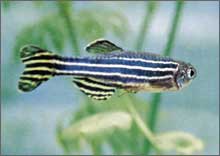 Oxygen-starved patches found within the world's oceans and coastal regions apparently trigger the development of more male than female fishes, reveals a recently released study by Rudolf Wu and colleagues at the City University of Hong Kong. This study not only has dire implications for the future of fish populations, but it also suggests that hypoxic conditions -- water containing less than 2.8 milligrams of oxygen per liter -- may be interacting directly with the hormones of the reproductive system, experts say.
Oxygen-starved patches found within the world's oceans and coastal regions apparently trigger the development of more male than female fishes, reveals a recently released study by Rudolf Wu and colleagues at the City University of Hong Kong. This study not only has dire implications for the future of fish populations, but it also suggests that hypoxic conditions -- water containing less than 2.8 milligrams of oxygen per liter -- may be interacting directly with the hormones of the reproductive system, experts say.
Wu and his colleagues studied a common and easily-kept freshwater fish, the zebrafish, Danio rerio (pictured), to understand the effects of low levels of dissolved oxygen, known as hypoxia, on embryonic development (LATimes, registration required).
In their experiments, they found that dissolved oxygen concentrations of less than 2 parts per million down-regulated the activity of genes that control the synthesis of sex hormones. This led to an increase in the ratio of testosterone to estradiol, which caused fishes that were genetically female to develop male secondary sexual characteristics, so they appeared to be males. As a result, newly-hatched male fishes outnumbered females by three-to-one. Additionally, most of the females had testosterone levels that were approximately twice as high as normal.
In contrast, zebrafish populations raised under normal oxygen conditions of more than 5 parts per million hatched with the expected sex ratio for this species of 60-40 males to females.
As these predominately male fish mature, it is unlikely they will be able to reproduce in sufficient numbers to maintain sustainable populations, Wu says. Low oxygen levels also might reduce the quantity and quality of the eggs produced by female fish, diminishing their fertility, he adds.
Oceanic "dead zones" are caused by agricultural fertilizers and other farm run-off, and by the discharge of animal and human sewage and other wastes into rivers and coastal areas. These nitrogen-rich waters form a nutritious soup that supports a population explosion of phytoplankton. When these phytoplankton die, they sink to the ocean floor where they are decomposed by bacteria. Bacterial decomposition depletes most of the oxygen in the surrounding waters, making survival difficult for marine life. Those marine creatures that manage to escape these dead zones are often weakened and may be more vulnerable to predators and other stresses.
This new study, Wu says, suggests these dead zones potentially pose a third threat to these species -- an inability of their offspring to find mates and reproduce.
This research will appear in the 1 May 2006 issue of the peer-reviewed journal, Environmental Science & Technology [DOI: 10.1021/es0522579].
Thanks, Diane!
- Log in to post comments
